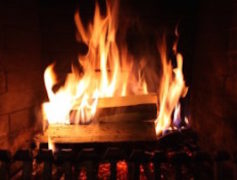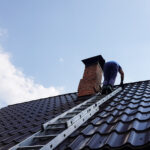
Thanks to Toolbox Tomgirl for this episode of Tips from the Pros staying safe while keeping warm this winter.
Although I personally have converted my wood burning fireplace to a pellet stove to supplement my electric heat, I want to offer some safety tips to those of you that are still using wood stoves and fireplaces. Because more than one-third of us are using wood burning stoves, fireplaces and other fuel burning appliances as a primary heat source, I feel it important to know some basic rules. Also, statistics show that heating fires account for 36 percent of residential home fires in rural areas every year.
With that said, please consider the following:
- Have your chimney, wood stove (and pellet stove) heating flues inspected and cleaned annually by a certified and licensed chimney professional (you all know how I feel about licensing<span). You can check for a licensed chimney professional at www.csia.com and then check their license status at www.dllr.state.md.us/license/mhic.
- Remember to only use seasoned wood (hardwood) in your fireplace. According to AARP, when wood isn’t properly seasoned (ideally for 2 years) the heat producing efficiency is reduced as much as 30%. Dry wood has cracks on the ends of the logs and running through each piece. Wood that has been split for a while should be gray, and the logs should feel dry and produce a hollow should when banged together. And, soft, moist wood accelerates creosote buildup which is harmful to your lungs. NEVER burn trash, paper, cardboard boxes, etc. in your fireplace (I remember as a kid when my Dad would burn different color coated wiring to make the flames different colors – yikes).
- Stack your firewood away from your house at least 30 feet away and keep it covered so it can season well. This also keeps termites away from any wood structures near your house. I learned about the termites the hard way when I had my fireplace.
- Keep your roof and gutters clear of leaves, pine needles, etc. so if sparks do come out of the chimney and land on the roof there is nothing for them to catch fire.
- This is something I hope you already do but it is worth repeating. Have smoke detectors and carbon monoxide alarms on every level of your home and be sure you have them inside and outside the sleeping areas if you keep the doors shut on those rooms at night. CHANGE the batteries at the same time you change the time on the clocks; you did it this past weekend – right?
- Finally, yet another vent to keep clean. I know, I know, you just love me when I find ANOTHER vent for you to have to remember. However, this one is a major vent and should be properly maintained. Everyone who has a gas or oil heat system has a vent that goes with that system. They must be kept properly cleaned and maintained. Ask your chimney service professional to care for this for you.
Before I leave you with all this warming knowledge I want to thank James Horne, Owner of Old Line Chimney Sweeps, in Pasadena, MD for some of the information provided in this article. Check them out at www.oldlinechimney.com.
To women holding hammers,
Jo Ellen Soesbee, The ToolBox TomGirl






Recent Comments